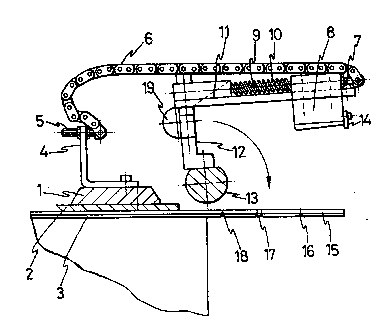Some of the information on this Web page has been provided by external sources. The Government of Canada is not responsible for the accuracy, reliability or currency of the information supplied by external sources. Users wishing to rely upon this information should consult directly with the source of the information. Content provided by external sources is not subject to official languages, privacy and accessibility requirements.
Any discrepancies in the text and image of the Claims and Abstract are due to differing posting times. Text of the Claims and Abstract are posted:
| (12) Patent Application: | (11) CA 2089681 |
|---|---|
| (54) English Title: | MECHANISM FOR LAP FOLDING AND REINFORCEMENT FORMING IN CARDBOARD BOXES |
| (54) French Title: | MECANISME DE PLIAGE ET DE RENFORCEMENT DE BOITES DE CARTON |
| Status: | Deemed Abandoned and Beyond the Period of Reinstatement - Pending Response to Notice of Disregarded Communication |
| (51) International Patent Classification (IPC): |
|
|---|---|
| (72) Inventors : |
|
| (73) Owners : |
|
| (71) Applicants : | |
| (74) Agent: | MARKS & CLERK |
| (74) Associate agent: | |
| (45) Issued: | |
| (22) Filed Date: | 1993-02-17 |
| (41) Open to Public Inspection: | 1994-04-27 |
| Availability of licence: | N/A |
| Dedicated to the Public: | N/A |
| (25) Language of filing: | English |
| Patent Cooperation Treaty (PCT): | No |
|---|
| (30) Application Priority Data: | ||||||
|---|---|---|---|---|---|---|
|
ABSTRACT
It is a simple device by means of which top quality
folding of laps, as well as of reinforcements of card-
board boxes, is obtained.
It consists of a base (1), to which a bottom sup-
port (4) provided with an adjustable screw (5) is con-
nected, to which an open chain (6), whose free end is
linked to a slipper (8), movable by a guide-shaft (9),
in which a push spring (10) of the slipper (8) and tension
spring of the chain (6) have been mounted, is connected.
The guide-shaft (9) is connected to a rear body (11) which
is joined to a main support (12) interlocked to an opera-
ting tree (13) of the entire mechanism.
With this arrangement, upon the tree (13) rotating
180°, a reinforcement column will be formed from a lap
(15), previously provided with the precise folding lines
and pushed by the slipper (8.)
Note: Claims are shown in the official language in which they were submitted.
Note: Descriptions are shown in the official language in which they were submitted.

2024-08-01:As part of the Next Generation Patents (NGP) transition, the Canadian Patents Database (CPD) now contains a more detailed Event History, which replicates the Event Log of our new back-office solution.
Please note that "Inactive:" events refers to events no longer in use in our new back-office solution.
For a clearer understanding of the status of the application/patent presented on this page, the site Disclaimer , as well as the definitions for Patent , Event History , Maintenance Fee and Payment History should be consulted.
| Description | Date |
|---|---|
| Inactive: IPC deactivated | 2021-10-09 |
| Inactive: IPC deactivated | 2021-10-09 |
| Inactive: IPC assigned | 2019-07-03 |
| Inactive: First IPC assigned | 2019-07-03 |
| Inactive: IPC expired | 2017-01-01 |
| Inactive: IPC expired | 2017-01-01 |
| Inactive: IPC from MCD | 2006-03-11 |
| Application Not Reinstated by Deadline | 1995-08-19 |
| Time Limit for Reversal Expired | 1995-08-19 |
| Deemed Abandoned - Failure to Respond to Maintenance Fee Notice | 1995-02-17 |
| Inactive: Adhoc Request Documented | 1995-02-17 |
| Application Published (Open to Public Inspection) | 1994-04-27 |
| Abandonment Date | Reason | Reinstatement Date |
|---|---|---|
| 1995-02-17 |
Note: Records showing the ownership history in alphabetical order.
| Current Owners on Record |
|---|
| JOSE BOIX JAEN |
| JOSE BOIX JAEN |
| Past Owners on Record |
|---|
| None |